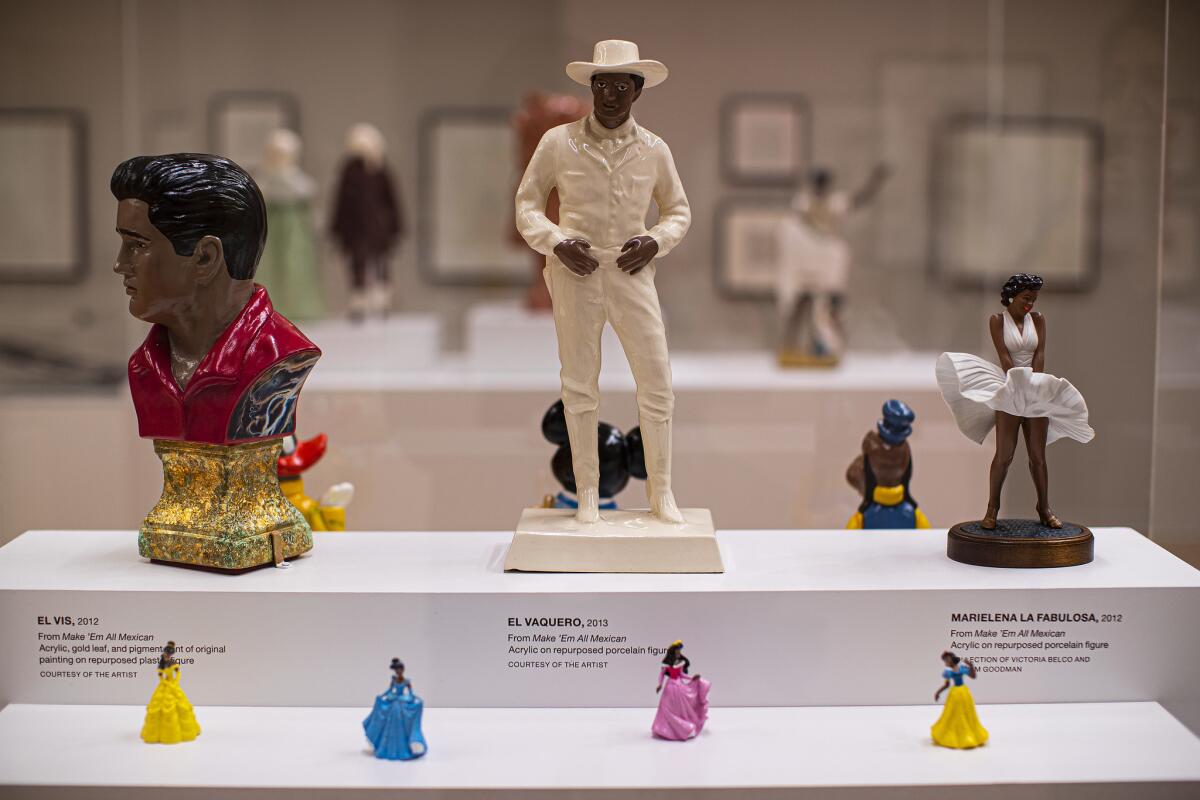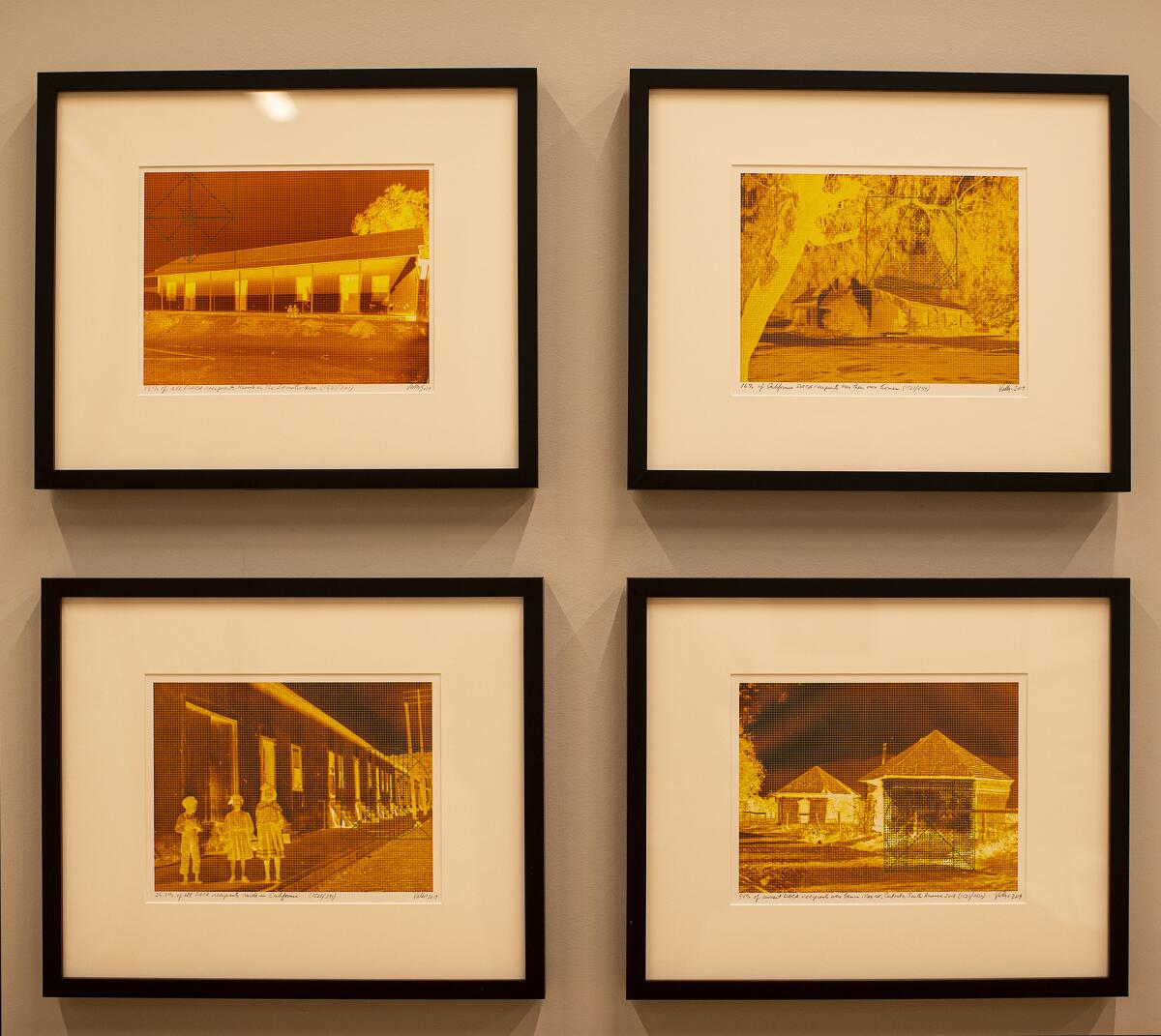Linda Vallejo and a decade of art that unapologetically embraces brownness

“He looks better brown, don’t you think?” Linda Vallejo asks, pointing at a small sculpture of hamburger chain mascot Bob’s Big Boy. His alabaster skin, however, has been painted a rich shade of mocha. The bright blue eyes are now deep brown, the hair a shock of slick black.
The work is part of Vallejo’s “Make ’Em All Mexican” series, in which the artist takes figures from pop culture, history and religion — Jesus, Gary Cooper, JFK, Mickey Mouse — and alters their appearance, darkening their skin, eyes and hair to flip traditional representations on their heads.
“When you begin looking at it, you begin to see that we are missing from this conversation. ‘Why aren’t I in this representation? Why isn’t my family included in this?’” she asks. “I’ve basically re-appropriated culture, taken it back and I’ve made it brown, so everybody gets to be brown.”
“Make ’Em All Mexican” is one of four series from the last decade to be included in Vallejo’s recently opened solo exhibition, “Linda Vallejo: Brown Belongings,” at LA Plaza de Cultura y Artes in downtown Los Angeles.
“All of the work deals with the focus of what it means to be a Latin American person born in the United States,” Vallejo says. “So I’m looking at that through a series of artworks that basically use the color brown to begin a discussion about the color of our skin, class and culture in the U.S.”

“Brown Belongings” features two portfolios that use demographic statistics about Latinx populations as the starting point for works. “Datos Sagrados” (Sacred Data) is a series of abstract, geometric designs rendered in shades of brown on round sheets of handmade paper. Vallejo begins by dividing the paper up into several shapes, then filling in a certain percentage of them to represent a corresponding statistic.
“This one here says that 30% of the U.S. population will be Latino in 2050,” she says. “We joke that they already are, it’s just that they haven’t been counted.”
“The Brown Dot Project” similarly begins with data culled from old census material, the Department of Labor and studies by the Pew Charitable Trusts. Vallejo maps the data onto gridded sheets of paper by meticulously filling in the appropriate number of dots. Statistics about Latinx participation in labor, religion, family, homelessness and education take the form of abstract compositions or representational depictions of objects and people, turning dry numbers into items of aesthetic contemplation.

For her “Cultural Enigmas” series, Vallejo painted symbols or parts of symbols drawn from cultures around the world, all divorced from their context. She calls these “cultural Rorschach tests” that invite viewers to bring their own interpretations to the works.
“The show lets us explore different themes that appear in her portfolios: exclusion and inclusion, appropriation and re-appropriation, taking back power,” lead curator Erin M. Curtis says. “ ‘Make ’Em All Mexican’ looks at how different the present would be if the past had been different, while ‘Cultural Enigmas’ looks out more broadly at how people might claim identity in the future. It’s a fantastic progression to trace.”
“Brown Belongings” is the largest solo show that LA Plaza has mounted and notably its first for a Latina since its founding in 2011. (Latina artists have been featured in group shows.) The four series mingled across two floors of the institution, drawing connections between disparate bodies of work.
“The element of humor was really important for us to maintain,” associate curator Mariah Berlanga-Shevchuk says, “because if you are just taking in the facts, it can beat you over the head and it can be a bit depressing. But by pairing ‘The Brown Dot Project’ with ‘Make ’Em All Mexican’ we wanted to add back that humor. It’s like having a conversation with Linda. There are some jokes in there that you might not expect, but there’s also a lot of substance.”
Despite the humor, much of Vallejo’s inspiration comes from a place of pain. Born in Boyle Heights in 1951, she spent her first few years in East L.A. before living in Germany, Spain and Alabama — moves driven by a father who was a colonel in the Air Force. It wasn’t until she moved back to Southern California in the late ’60s that she connected with her Mexican American heritage.
ON VIEW: How guerrilla art on the streets of South L.A. confronts scars from the 1992 riots »
“I grew up Middle-American,” she says. “My parents were punished in grade school for speaking Spanish, so they were doing everything they knew how to do to assimilate, to become American.”
One of Vallejo’s first pieces in “Make ’Em All Mexican” was based on the classic children’s book “Dick and Jane,” in which she darkened the characters’ skin — not enough to be jarring but just enough to widen the scope of representation.
“Almost every American child that went to elementary school in the 1950s read this book,” she says. “And everyone [in it] was all white, redheads, blue eyes, very fair, this happy family with the dog. So there’s a sense of exclusion even to a child, and children are very sensitive to these kinds of things.”
Although “Brown Belongings” unapologetically embraces and explores the many facets of brownness, Vallejo and the curators are quick to point out that the show is meant to appeal to a wide audience, to inspire connections as opposed to barriers.
“The works are experienced best not only through a sort of one-to-one connection between visitor and art, but where art sparks a dialogue that is meant to invite people into a history they might not see themselves in,” Curtis says. “My hope is that it gets people having conversations. There’s a lot of joy and humor, so it lets people laugh and work through issues collectively.”
=====
‘Linda Vallejo: Brown Belongings’
Where: LA Plaza de Cultura de Artes, 501 N. Main St., L.A.
When: Noon-5 p.m. Mondays, Wednesdays and Thursdays; noon-6 p.m. Fridays-Sundays
Admission: Free
Info: (213) 542-6259, lapca.org
=====
Support our coverage of local artists by becoming a digital subscriber and reading our latest news and reviews at latimes.com/arts.
More to Read
The biggest entertainment stories
Get our big stories about Hollywood, film, television, music, arts, culture and more right in your inbox as soon as they publish.
You may occasionally receive promotional content from the Los Angeles Times.






